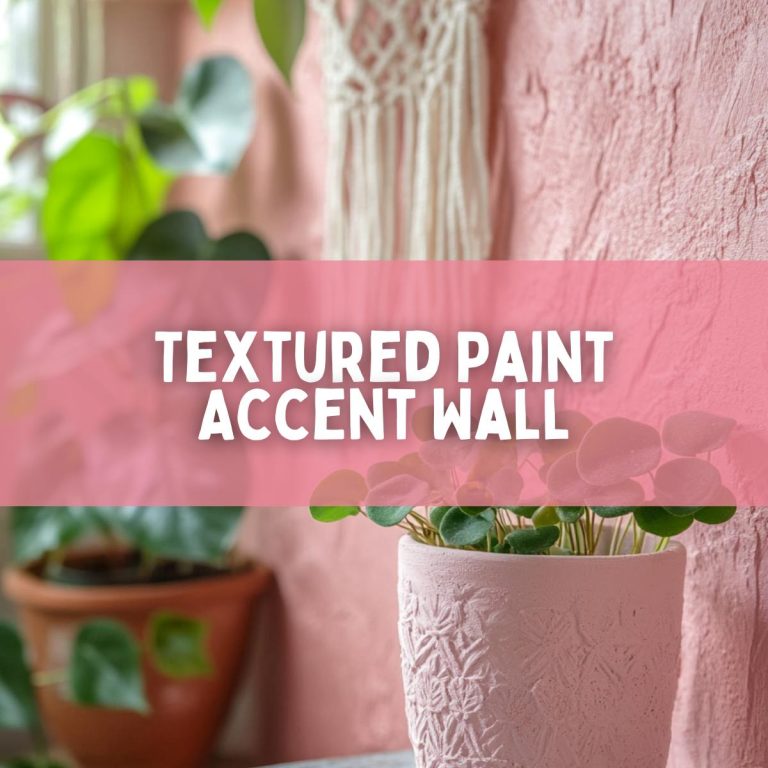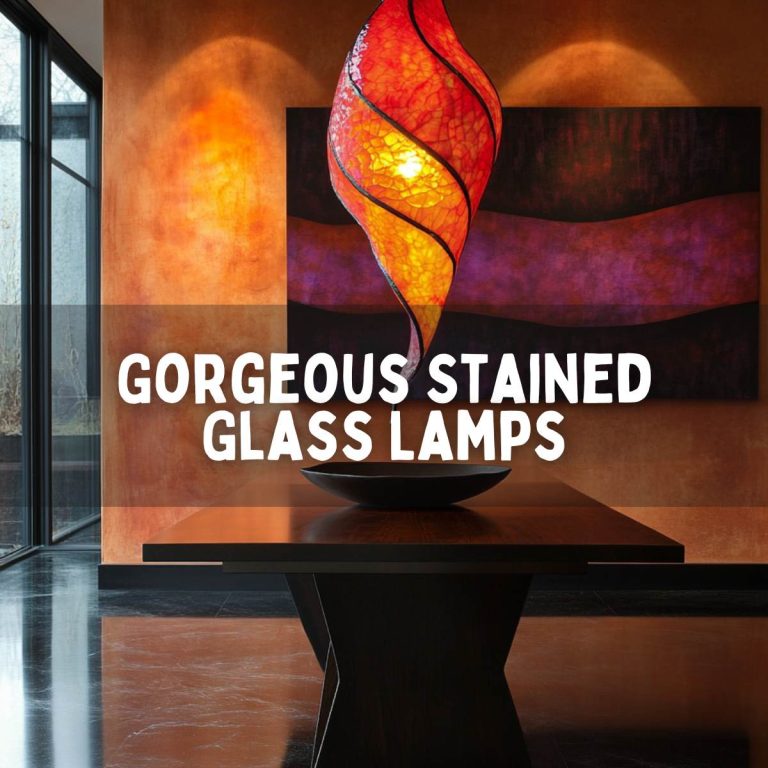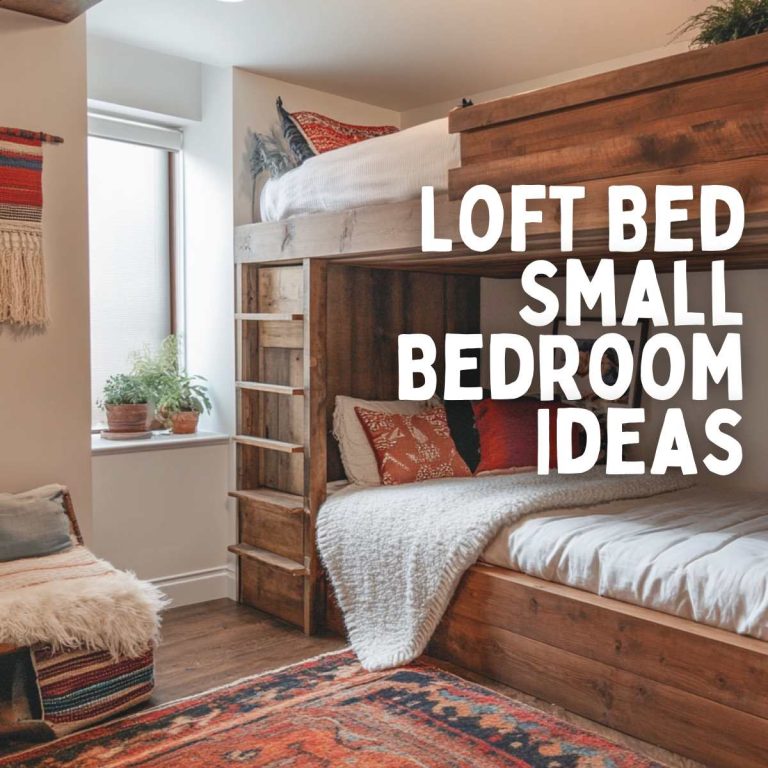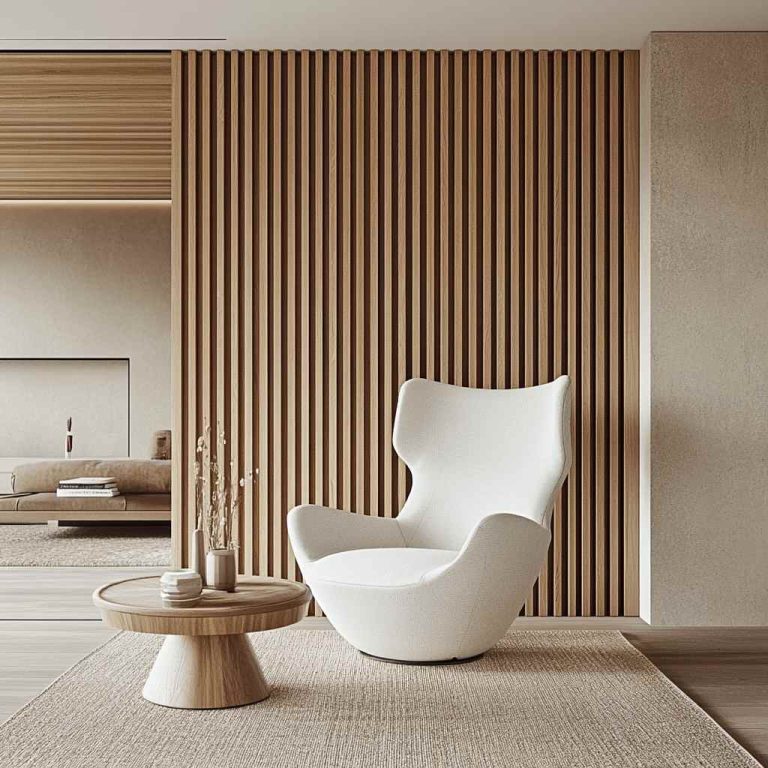Features of Modern Accent Walls: Transforming Spaces with Wood, Concrete, Glass, and More
In the world of interior design, accent walls have emerged as powerful tools for transforming spaces. No longer limited to mere splashes of bold color, today’s accent walls embrace sophisticated materials like wood, concrete, glass, ceramic tiles, brick, marble, and mirror panels to create breathtaking focal points. They are not just decorative elements—they are expressions of personality, mood, and architectural taste.
Modern interiors value clarity, minimalism, and impact. Accent walls serve these needs by delivering dramatic visual interest without cluttering the space. They ground the design, draw the eye, and define areas within open floor plans—all while highlighting craftsmanship and material beauty.
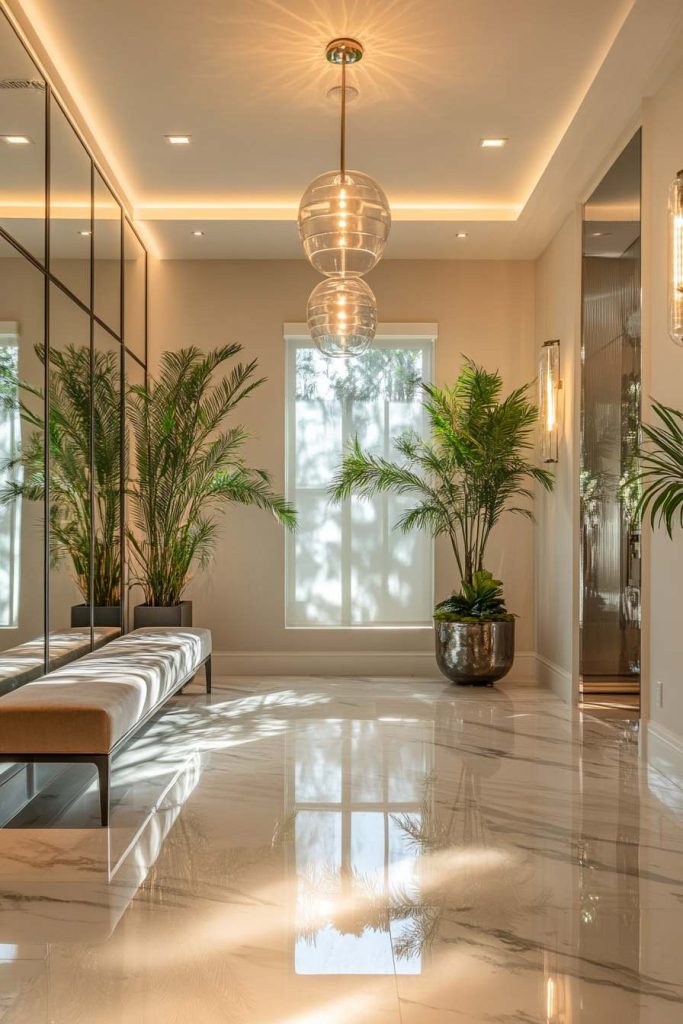
Characteristics of Modern Accent Walls
Minimalist Aesthetics
Modern accent walls often follow the principle of “less is more”—favoring clean lines, subtle textures, and understated elegance over elaborate designs.
Focus on Material Authenticity
Instead of masking materials with excessive paint or decoration, modern designs celebrate the natural look and feel of wood grains, concrete surfaces, stone veins, and reflective glass.
Integration with the Overall Space
An effective modern accent wall feels like a natural extension of the room, not an afterthought. It complements the overall palette, textures, and architectural features.
Functionality Meets Artistry
Today’s accent walls are both functional and artistic. Whether it’s providing insulation (wood), light diffusion (glass panels), or simple spatial division, modern accent walls often serve a dual purpose.
The Power of Material Choice in Accent Walls
Material selection is the foundation of a successful accent wall. In modern spaces, it’s not only about aesthetics but also about how the material interacts with light, space, and mood. Each material brings its own story, tactile feel, and emotional resonance.
- Wood introduces warmth, comfort, and a timeless organic connection.
- Concrete conveys strength, urban sophistication, and minimalism.
- Glass symbolizes openness, innovation, and fluidity.
- Ceramic tiles add vibrancy, texture, and versatility.

Choosing the right material enhances not just the visual appeal but also defines the room’s atmosphere, whether cozy, luxurious, bold, or serene. It’s important to match the material with the functionality of the space and its overall design language.
Wood Accent Walls
Wood has remained a timeless favorite in interior design because of its natural beauty, tactile quality, and incredible adaptability across styles.
Types of Wood Used (Reclaimed, Engineered, Natural Timber)
- Reclaimed Wood: Harvested from old barns, factories, or warehouses, reclaimed wood brings character and sustainability into a space. Its imperfections—nail holes, knots, and weathering—tell a rich story.
- Engineered Wood: Comprising a veneer layer of real wood over plywood or fiberboard, engineered wood is cost-effective, stable, and less susceptible to moisture and temperature changes—ideal for modern homes that seek efficiency without sacrificing appearance.
- Natural Timber: Solid hardwood panels such as oak, walnut, maple, or teak offer unmatched authenticity. They often come untreated or lightly oiled to retain the raw, earthy feel essential for organic modern interiors.
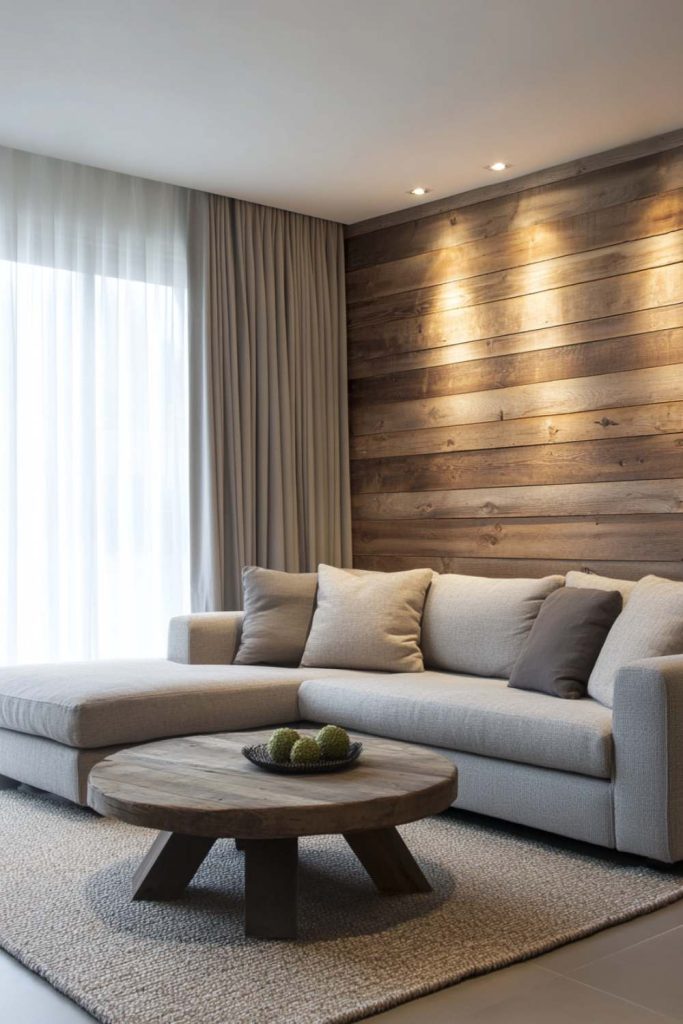
Finishes and Treatments (Matte, Stained, Raw)
- Matte Finish: A non-glossy, muted finish that enhances the wood grain without reflections, perfect for minimalist or Scandinavian spaces.
- Stained Wood: Staining can darken the wood, accentuate grains, or even change the tone to match surrounding furniture. It adds a layer of protection as well as aesthetic depth.
- Raw Wood: Leaving wood untreated highlights its purest natural state. This rustic approach fits perfectly in Japandi, Wabi-Sabi, or organic modern styles.
Best Room Placements for Wooden Accent Walls
- Living Rooms: Behind sofas or fireplaces, creating a cozy gathering spot.
- Bedrooms: As a dynamic alternative to traditional headboards.
- Home Offices: Infusing warmth into workspaces, enhancing focus and comfort.
Concrete Accent Walls
Concrete in modern interiors has moved from a utilitarian material to a statement of urban sophistication. It’s bold, strong, and surprisingly versatile.
Raw Concrete vs Polished Concrete
- Raw Concrete: Presents a rugged, unfinished look, embracing surface imperfections, marks, and formwork patterns. Perfect for industrial, loft, or minimalist styles.
- Polished Concrete: Achieved through grinding and polishing, this surface becomes smooth, reflective, and elegant. It suits spaces aiming for a sleek, modern, and luxurious vibe.
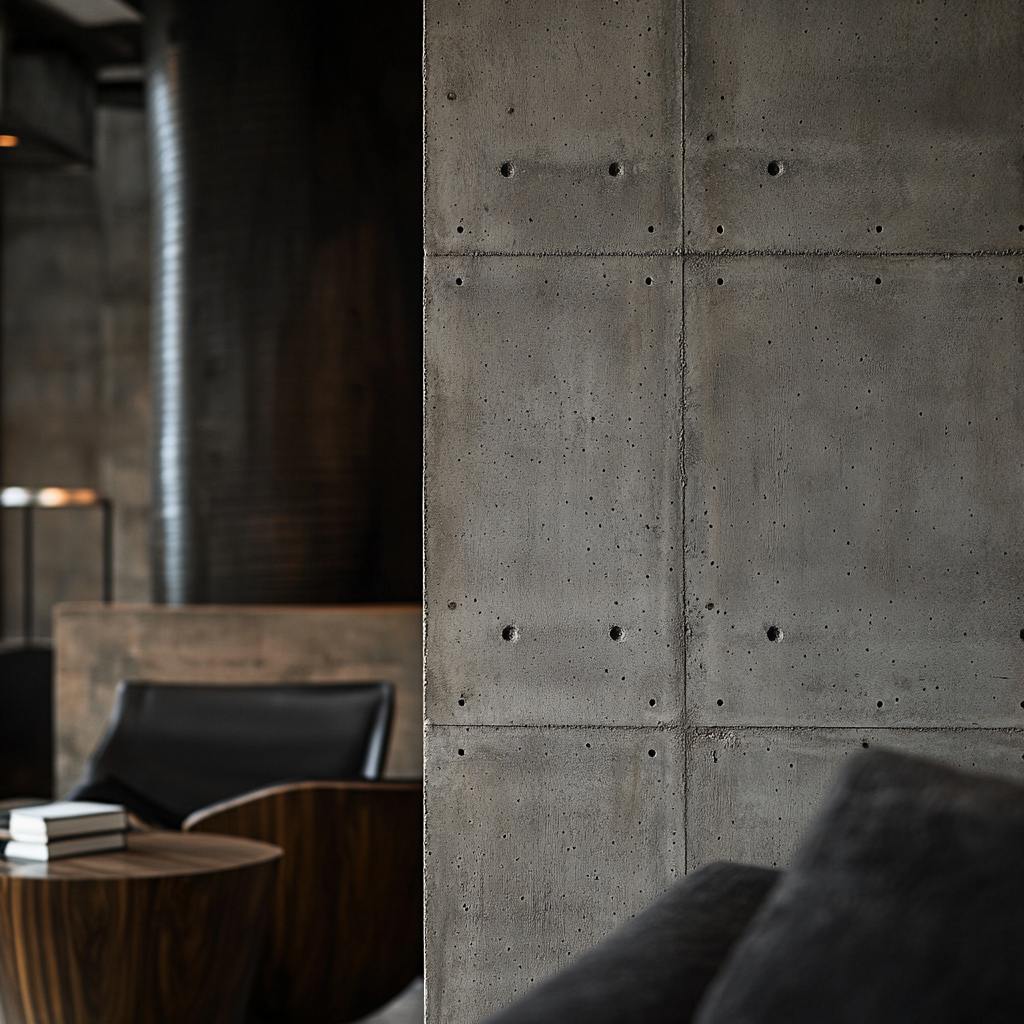
Creating Texture with Concrete
Concrete doesn’t have to be flat and boring. Designers create depth and interest by:
- Board-form Concrete: Using wooden planks in the casting mold to imprint wood grain onto the concrete.
- Textured Concrete Panels: Precast panels with ridges, waves, or geometric motifs.
- Hand-troweled Finishes: Applying subtle, artistic variations in tone and surface movement.
These textures catch light differently throughout the day, giving life to what might otherwise feel static.
Ideal Spaces for Concrete Applications
- Living Rooms: Especially in open-plan urban apartments.
- Kitchens: Concrete walls combined with metallic or wooden cabinetry for a high-end industrial look.
- Bathrooms: Paired with sleek glass or black fixtures, creating a modern spa-like retreat.
Glass Accent Walls
Glass brings lightness, elegance, and flexibility to modern interiors, helping spaces feel larger, brighter, and more fluid.
Frosted vs Clear Glass
- Frosted Glass: Created through sandblasting or acid etching, it blurs visibility while allowing light penetration. It’s ideal for privacy without closing off a room visually.
- Clear Glass: Offers unobstructed views and maximizes natural light, dissolving the sense of barriers. It’s excellent for maintaining a continuous flow between connected spaces.
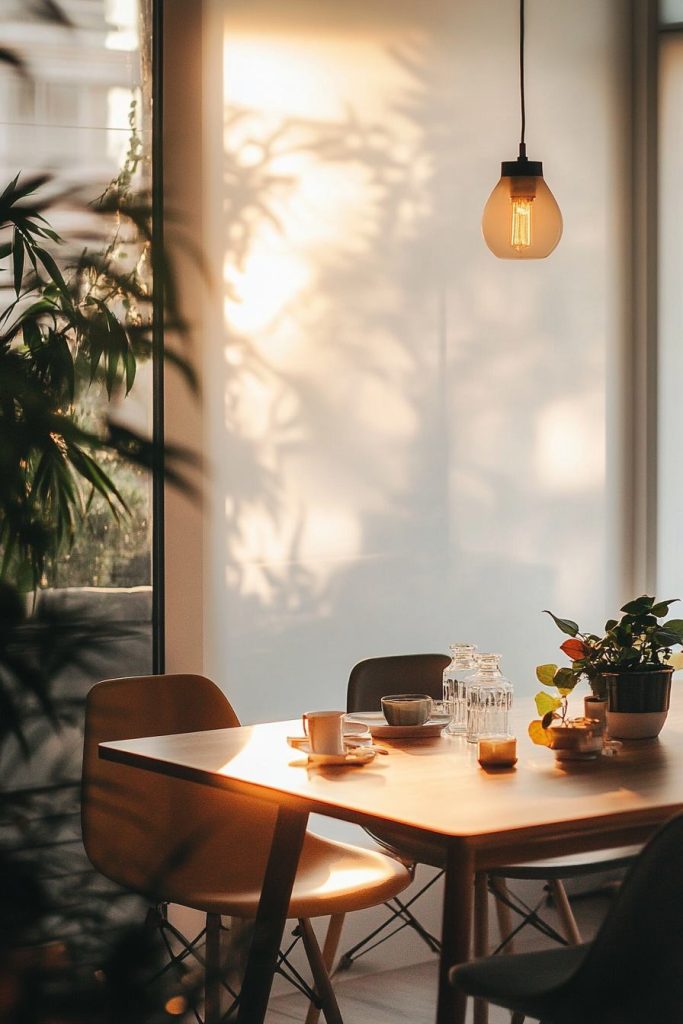
Colored and Textured Glass for Depth
Modern glass technology allows for:
- Colored Glass: Subtle tints like smoked gray, bronze, or pastel hues add depth and character.
- Textured Glass: Rippled, patterned, or hammered finishes that scatter light beautifully, providing both privacy and artistic intrigue.
Where Glass Accent Walls Shine Best
- Foyers and Entrances: Welcoming guests with open, inviting spaces.
- Home Offices: Dividing work areas without sacrificing openness or light.
- Bathrooms: As partitions between showers and vanities, blending privacy with design elegance.
- Ceramic Tile Accent Walls
Ceramic tiles are making a bold comeback with cutting-edge designs, improved durability, and limitless aesthetic options.
Modern Tile Trends (Large Format, Geometric Patterns)
- Large Format Tiles: Dramatically sized tiles (24×48 inches or larger) create a seamless, monolithic look with minimal grout lines—ideal for creating clean, modern backdrops.
- Geometric Patterns: Hexagons, chevrons, herringbone, and custom-cut shapes bring playful energy and movement into a space while staying within a sophisticated, orderly frame.
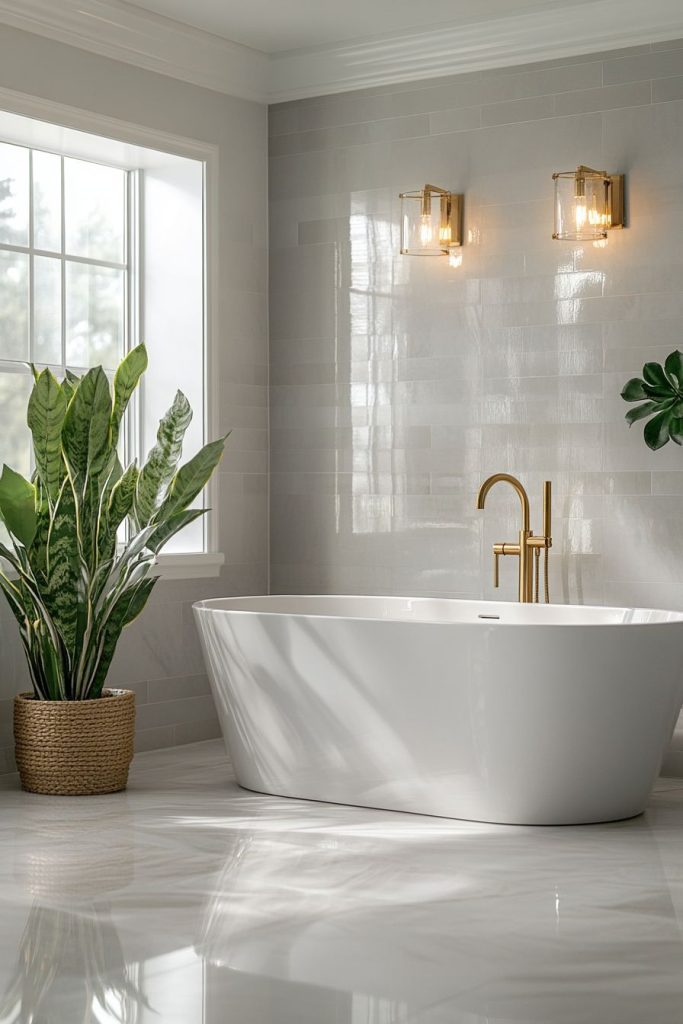
Other trends include handmade-look tiles with slight imperfections for an artisanal touch, even in ultra-modern settings.
Glazed vs Unglazed Finishes
- Glazed Tiles: Have a liquid glass coating that makes them glossy, waterproof, and easy to clean. They’re perfect for accent walls that need to shimmer or reflect light.
- Unglazed Tiles: Possess a more natural, earthy, matte finish. They offer better slip resistance and exude an understated luxury.
Choosing between them depends on whether you want your accent wall to sparkle under lighting or anchor the room with subtle texture.
Best Locations for Ceramic Tile Accent Walls
- Bathrooms: Behind bathtubs or in walk-in showers, creating luxurious spa vibes.
- Kitchens: Extending the backsplash upwards onto a full wall for high visual impact.
- Entryways and Hallways: As statement art walls, using patterned or sculpted tiles for a memorable first impression.
Brick Accent Walls
Brick brings an unmatched sense of character, authenticity, and timelessness to modern spaces. Whether left raw, painted, or integrated into sleek designs, brick has transcended its industrial roots to become a centerpiece of sophisticated interiors.
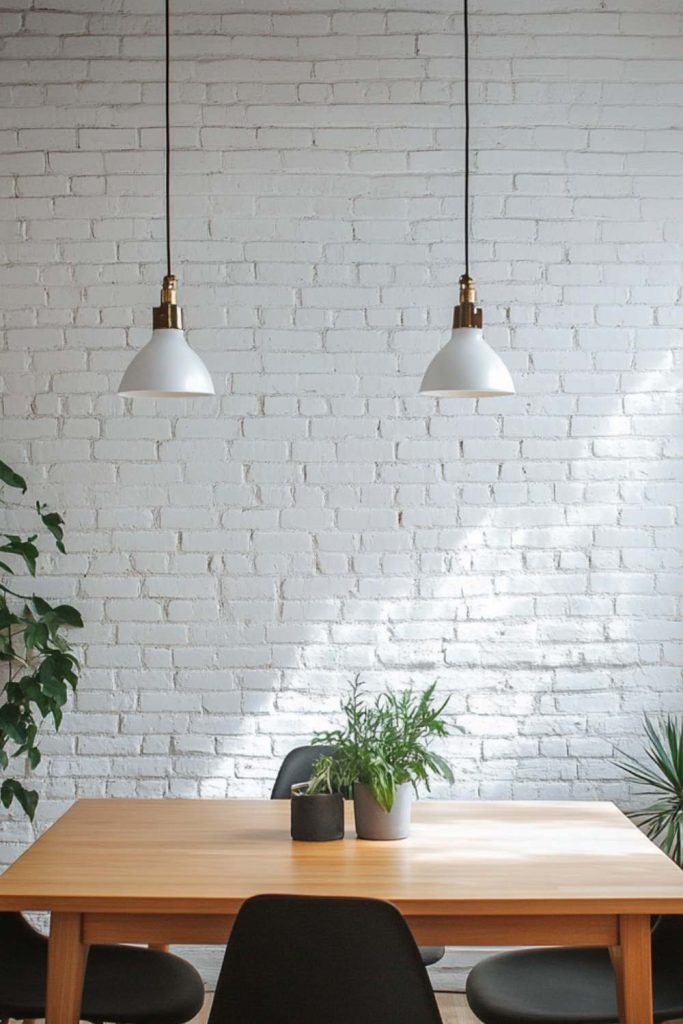
Exposed Brick for Urban Chic
Exposed brick walls exude urban charm and historic depth, making them especially popular in loft apartments, converted warehouses, and industrial-inspired homes. The inherent texture, color variation, and imperfections of brick create a dynamic backdrop that:
- Adds visual warmth in contrast to metal or glass.
- Brings a sense of architectural authenticity to modern minimalist settings.
- Creates a neutral yet textured canvas for diverse furnishings—whether vintage, contemporary, or eclectic.
The beauty of exposed brick lies in its imperfect, organic appeal, and it often becomes the focal point of an open-plan layout.
Painted Brick
Painting brick is a clever way to adapt its raw texture to different design languages:
- White-painted brick softens the roughness and provides a bright, Scandinavian feel.
- Gray brick leans into an industrial, sophisticated look, especially when paired with polished concrete or matte black accents.
- Black-painted brick adds moody drama and modern boldness, particularly effective in feature walls for living rooms or entertainment areas.
Painted brick retains the depth and dimension of the material while allowing homeowners to coordinate with broader color schemes.
Maintaining and Sealing Brick Walls
Brick is inherently porous, meaning it can:
- Absorb moisture, leading to potential mildew or crumbling.
- Attract dust within its textured surface.
Proper maintenance includes:
- Sealing: Applying a clear, breathable sealer every few years to protect against moisture and staining.
- Cleaning: Using gentle methods like dry brushing or vacuuming rather than harsh chemicals that could erode the material.
- Touch-up painting: For painted brick, occasional repainting may be necessary to keep the wall fresh and vibrant.
Marble Accent Walls
Marble epitomizes luxury, elegance, and timeless sophistication. In modern spaces, marble accent walls elevate rooms with their natural beauty and dramatic visual impact.
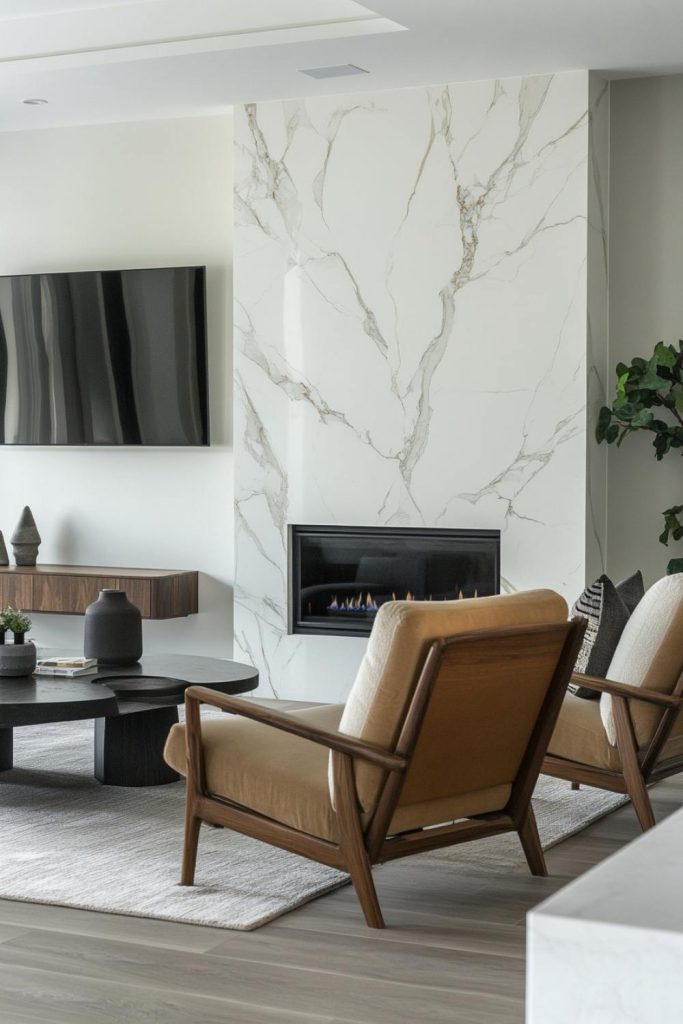
Types of Marble
- Carrara Marble:
Known for its soft white background and feathery gray veining, Carrara marble is subtle yet classic. It’s ideal for understated elegance and suits minimalist or traditional modern styles. - Calacatta Marble:
Rarer and more dramatic than Carrara, Calacatta features a bright white base with bold, thick veins in gray or gold tones. It is often used for luxury statement walls where opulence is desired. - Nero Marquina Marble:
Hailing from Spain, this deep black marble with sharp white veining makes for a striking, high-contrast design perfect for dramatic, avant-garde interiors.
Bookmatching Techniques
Bookmatching is a highly sought-after design technique where two marble slabs are placed side by side so that their veining mirrors each other, like the pages of an open book. This method:
- Creates symmetry and visual drama.
- Highlights the natural art of the marble itself.
- Enhances luxury, often seen in hotel lobbies, upscale homes, and boutique commercial spaces.
When properly executed, bookmatched marble accent walls can feel like a natural mural, full of rhythm and movement.
Spaces Where Marble Creates Maximum Impact
- Feature Walls in Luxury Bathrooms: Behind bathtubs or walk-in showers, offering a spa-like, opulent atmosphere.
- Behind Living Room Fireplaces: Creating a magnificent focal point that radiates refinement.
- Dining Rooms: As a sophisticated backdrop that elevates the entire dining experience.
Glass Panel Accent Walls
Glass panel accent walls embody transparency, fluidity, and sleek sophistication. They fit beautifully in interiors aiming for a clean, uncluttered, and expansive feeling.
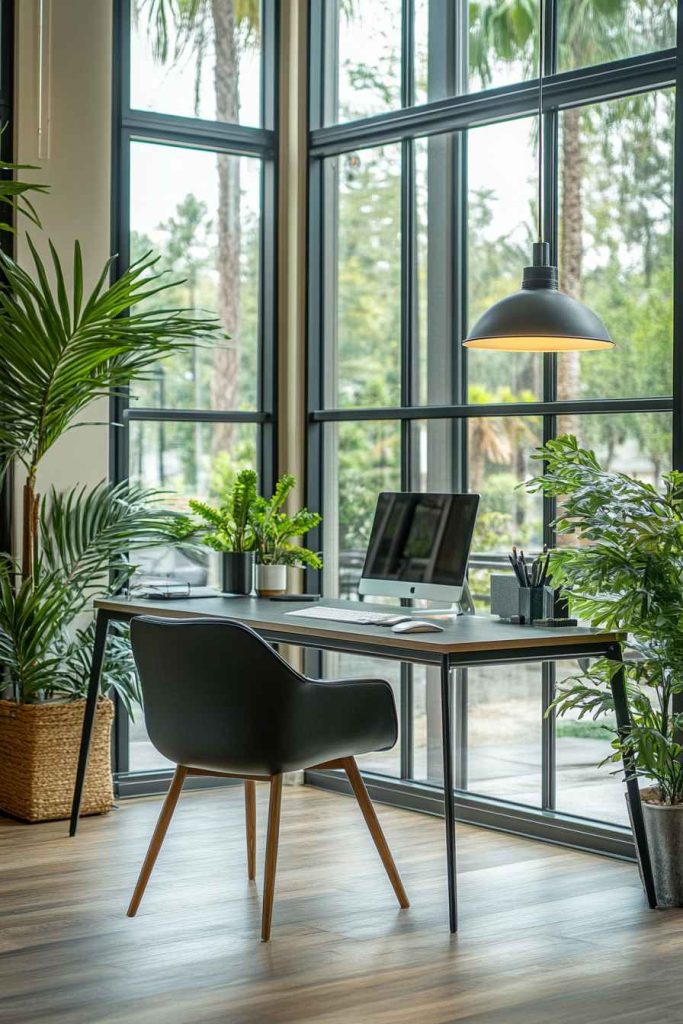
Frameless Designs
Modern designs favor frameless glass panels that create a seamless flow between spaces:
- No heavy frames to interrupt the view.
- Minimal hardware enhances the sense of continuity.
- Perfect for high-end residential or commercial projects that demand a light, airy aesthetic.
Frameless glass accent walls allow for visual connection between spaces while maintaining acoustic or functional separation.
Adding Backlighting
Introducing LED backlighting behind frosted, tinted, or even clear glass panels dramatically elevates their visual impact:
- Creates a glow effect that can be customized in color and intensity.
- Highlights textures or patterns within the glass.
- Enhances ambiance in evening or low-light conditions, making the wall feel like a piece of illuminated art.
Placement Ideas
- Home Offices: Separate workspaces stylishly without sacrificing natural light.
- High-End Restaurants: Define dining zones while retaining a sense of openness.
- Residential Lobbies: Impress visitors with a dramatic, illuminated welcome feature.
Mirror Panel Accent Walls
Mirrors are among the most transformative tools in interior design. As accent walls, they can expand space, amplify light, and inject glamour into a room effortlessly.

Enhancing Light and Perceived Space
Mirrors multiply both natural and artificial light, which:
- Brightens dim spaces dramatically.
- Visually enlarges small or narrow rooms.
- Enhances the architectural features of a room by reflecting its most beautiful angles.
In small urban apartments or tight corridors, mirror panels can make a space feel twice as large and airy.
Modern Layouts
- Gridded Mirrors:
Mirrors divided into a grid of framed sections create a structured, almost architectural aesthetic. These work well in modern industrial or contemporary settings. - Full-Sheet Mirrors:
A single expanse of mirror that covers an entire wall creates a luxurious, minimalist statement—perfect for grand living rooms or master bedrooms. - Organic Shapes:
Non-linear, flowing mirror installations offer a soft, artistic touch. They are great for breaking up rigid layouts or adding whimsy to ultra-modern spaces.
Best Rooms for Mirror Accents
- Dining Rooms: Amplifies the conviviality and light, making meals feel festive and special.
- Living Rooms: Opens up the core gathering space, making it feel more expansive and lively.
- Entryways: Sets a stunning first impression, instantly giving visitors a sense of openness and luxury.
Mixing Materials: Blending Wood, Concrete, and Glass
In modern design, mixing materials isn’t just allowed—it’s celebrated. The art of combining textures and surfaces breathes life into interiors, creating spaces that are dynamic, layered, and deeply engaging.

Techniques for Harmonious Combinations
- Balance Dominant and Secondary Materials:
Choose one primary material (like wood) and complement it with accents of concrete or glass. This prevents the wall from feeling chaotic. - Coordinate Color Temperatures:
Warm woods (like oak or walnut) pair beautifully with cool materials (like gray concrete or frosted glass) when there’s a deliberate color strategy. - Respect Proportions:
Allow each material to claim its own space rather than forcing small, confusing patches of multiple materials. - Use Transition Details:
Incorporate metal trims, LED strips, or grout joints to create elegant transitions between different textures.

Visual Balancing of Textures and Colors
- Contrast Smooth with Rough: For example, rough-hewn wood panels alongside polished glass.
- Mix Matte and Glossy Finishes: Concrete’s matte finish with the sleekness of mirror or glass for a compelling tactile story.
- Vary Scale: Use large slabs of marble next to small brick textures for visual depth and rhythm.
By blending wood’s organic warmth, concrete’s raw minimalism, and glass’s shimmering transparency, designers craft walls that feel both curated and spontaneous, natural yet structured.
Color Palettes for Modern Accent Walls
While materials provide texture and substance, color remains the most powerful visual cue to set the tone and mood of a room. Modern accent walls often embrace color strategies that enhance the beauty of the chosen materials rather than overpower them.
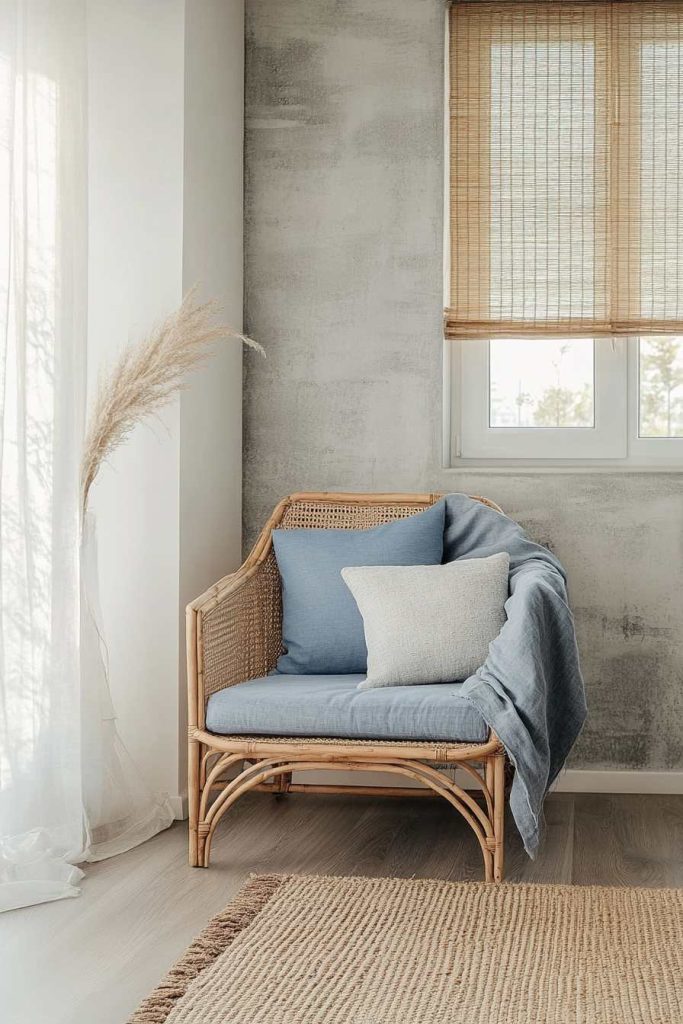
Neutral Tones with Material Contrast
Neutral color palettes emphasize the texture and authenticity of surfaces without competing for attention.
- Soft Whites and Off-Whites:
Ideal with wood or ceramic tiles. They provide a crisp, clean backdrop that lets the material’s grain or pattern shine. - Muted Grays and Charcoal:
Especially effective with concrete or glass. Grays bring sophistication and allow accent lighting to create subtle plays of shadow. - Beiges and Warm Taupes:
These pair naturally with brick and marble, offering a cozy yet upscale feel.
Neutral backgrounds also make bolder material textures stand out — like the ruggedness of raw brick or the intricate veining of marble.
Bold Colors with Subtle Materiality
When materials have less intense natural patterns (like light wood or polished concrete), bold colors can play a more dominant role:
- Deep Navy Blues:
Pair beautifully with white marble or light wood, offering a nautical yet refined mood. - Emerald Greens:
An opulent backdrop for gold-veined Calacatta marble or warm oak panels. - Terracotta and Rust Tones:
These earthy hues complement brick walls and reclaimed wood, creating spaces that feel grounded and connected to nature. - Black or Charcoal Accents:
Perfect when paired with mirror panels or polished concrete, giving a sleek, dramatic, and ultra-modern vibe.
When using bold colors, it’s crucial to balance them with lighter elements—furniture, flooring, or textiles—to prevent the room from feeling too heavy or enclosed.
Color Palettes for Modern Accent Walls
Choosing the right color palette is critical when designing a modern accent wall. Color defines mood, temperature, and spatial perception, and when combined thoughtfully with materials like wood, marble, or ceramic, it can elevate an ordinary wall into a breathtaking focal point.
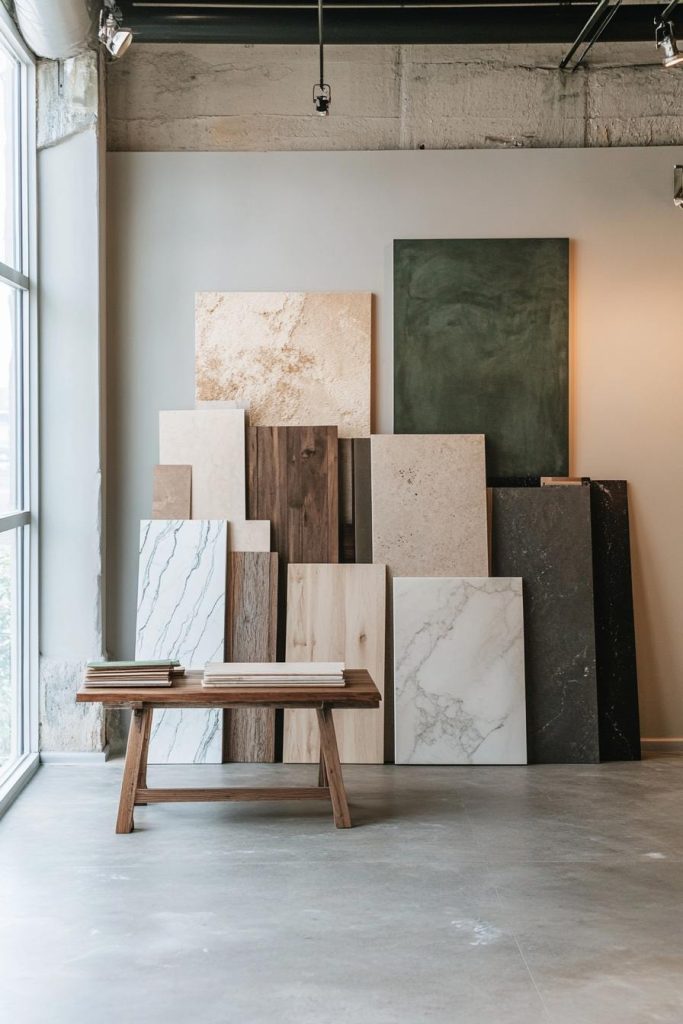
Neutral Palettes: Timeless Elegance and Versatility
Neutral colors are the foundation of modern interior design because they allow material textures and architectural details to stand out without distraction.
- Beige: Offers warmth and subtle sophistication; pairs beautifully with natural wood and lightly textured concrete.
- Taupe: A muted blend of gray and brown, taupe provides an understated elegance ideal for marble or ceramic walls.
- Black: Bold yet neutral, black accent walls create dramatic, moody backdrops for high-gloss materials like mirror panels or polished marble.
- Gray: The quintessential modern neutral, gray works across industrial, minimalist, and Scandinavian styles, harmonizing with concrete, glass, and reclaimed wood.
Highlighting material textures against these neutral backdrops ensures the organic beauty of wood grain, brickwork, or marble veining remains the star of the show.
Bold Palettes: Injecting Energy and Personality
For spaces that crave a sense of vibrancy or luxury, bold colors can be used without overwhelming the design:
- Deep Blues (Navy, Sapphire):
Evoke calm, depth, and stability. Deep blue accent walls behind white marble or light wood create a rich, grounded contrast. - Emerald Greens:
Symbolic of freshness and growth, emerald walls pair spectacularly with both gold-veined marble and handmade ceramic tiles, introducing an element of opulence and vitality. - Terracottas and Rust Tones:
These warm, earthy hues connect interiors to nature, making them ideal partners for brick, reclaimed wood, and matte ceramics. They create a welcoming, grounded atmosphere without feeling heavy.
When using bold palettes, it’s important to balance them with natural light, neutral flooring, and restrained decor to avoid overwhelming the space.
Lighting Accent Walls to Maximize Impact
Lighting is essential for accent walls because it brings out textures, colors, and materials, revealing their full beauty and transforming the wall from merely decorative to utterly captivating.
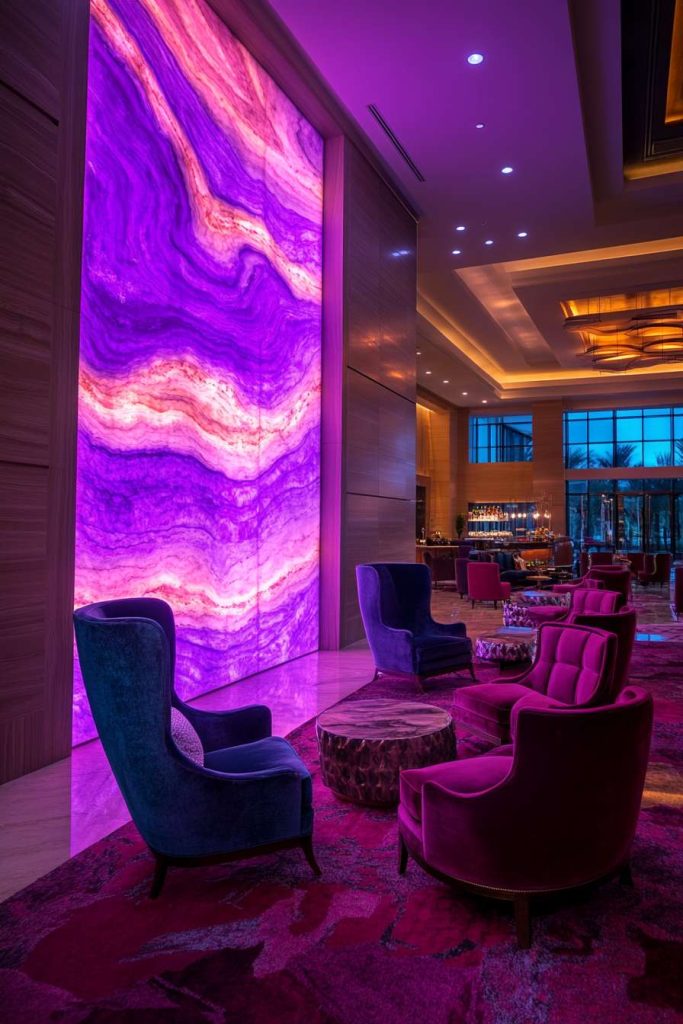
Ambient Lighting: General Illumination
Ambient lighting provides the overall brightness in a room. It’s typically created through ceiling fixtures, recessed lights, or large pendant lamps. Good ambient lighting ensures:
- The room feels inviting and cohesive.
- The accent wall integrates naturally into the broader design, without standing isolated.
However, ambient lighting alone often flattens material textures, so additional layers are necessary.
Task Lighting: Function-Oriented Illumination
Task lighting serves specific, practical purposes like reading, cooking, or working. When used thoughtfully near an accent wall:
- It can create interesting focal points, such as lighting a reading nook with a wood-paneled backdrop.
- It subtly draws attention to textured surfaces while maintaining utility.
Examples include wall-mounted reading lights, under-cabinet kitchen lighting, or adjustable floor lamps.
Accent Lighting: Spotlighting Texture and Artistry
Accent lighting is where the magic happens for modern accent walls:
- Spotlights: Directed beams that emphasize materials like rough brick, rippled concrete, or bookmatched marble.
- Wall Washers: Linear lights that “wash” an entire wall with soft, diffuse light, highlighting surface imperfections and textures beautifully.
- LED Strips: Concealed behind panels, trims, or floating shelves to create an ethereal glow that accentuates glass, mirrors, or floating wood slats.
Strategically layering these lighting types amplifies drama and enhances the architectural story of your accent wall.
Sustainable and Eco-Friendly Accent Walls
In modern design, aesthetics and responsibility must go hand in hand. Sustainable accent walls are not only beautiful but also contribute to healthier indoor environments and reduced environmental impact.
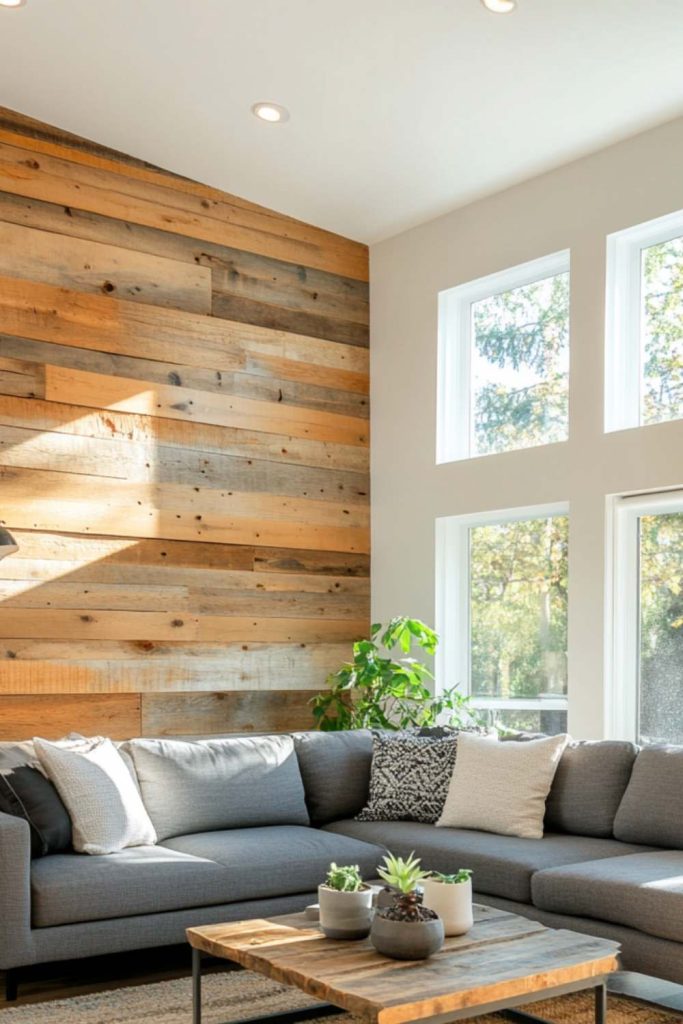
Key Sustainable Material Options:
- Recycled Wood Panels:
Use reclaimed barn wood, old flooring, or salvaged timber. This practice preserves resources and brings a rich, lived-in texture to your space. - Low-VOC (Volatile Organic Compounds) Sealants and Paints:
Traditional paints and finishes can emit harmful chemicals. Low-VOC options protect indoor air quality without compromising on durability or beauty. - Eco-Friendly Ceramic Tiles:
Many modern ceramics are produced with recycled content or energy-efficient manufacturing processes. Handmade artisan tiles often use natural clay and environmentally conscious glazing methods.
Investing in sustainable materials ensures your accent wall is not just stylish—but future-conscious and ethically made.
Installation Tips and Tricks for Perfect Accent Walls
Creating a stunning accent wall starts long before the first tile or panel is installed. Attention to preparation and professional technique makes the difference between amateurish and awe-inspiring.
Surface Prep: The Invisible Key to Success
Before installation:
- Ensure the wall is dry, clean, and free of dust.
- For heavy materials like marble or concrete panels, check load-bearing capacity and reinforce if necessary.
- Use primer or bonding agents to ensure adhesives work properly, especially on glass or ceramic surfaces.
A poorly prepped surface can lead to cracking, detachment, and premature deterioration.
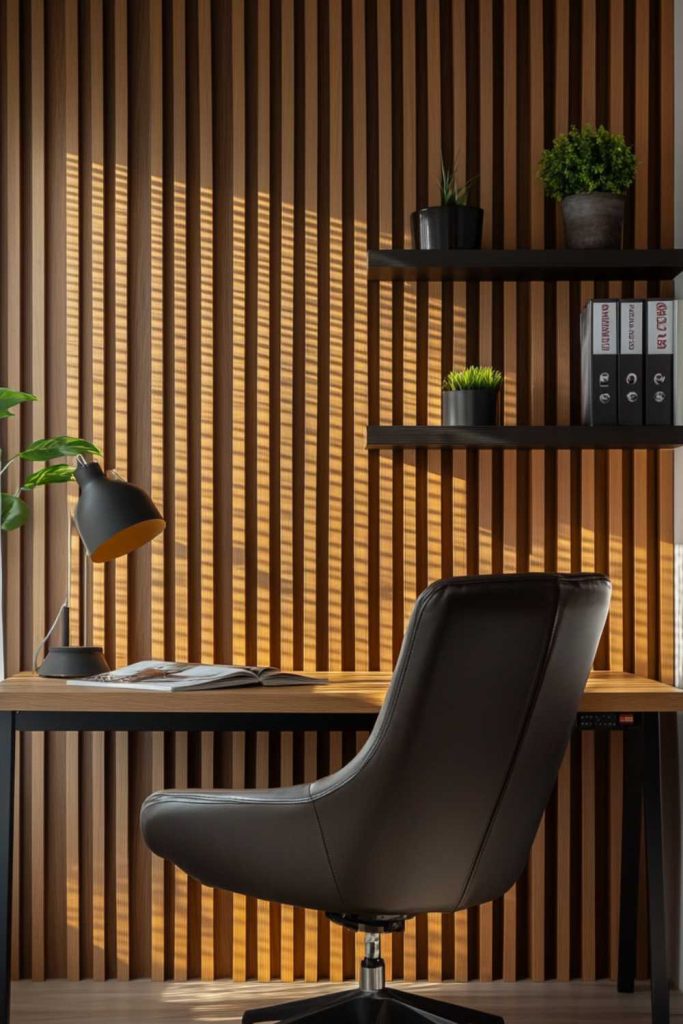
Professional Help: When It’s Worth It
- Marble, glass, and large panels require specialized cutting, heavy-duty adhesives, and precision alignment.
- Professionals also know how to seal joints, adjust for uneven walls, and integrate lighting seamlessly.
Hiring experts often saves money in the long run by preventing costly mistakes.
DIY Friendly Options
For those who love a hands-on project:
- Wooden Slat Walls: Pre-cut wooden slats mounted with simple adhesive strips or screws.
- Peel-and-Stick Brick Veneers: Lightweight, easy-to-install panels that mimic the charm of real brick without the hassle.
Always follow manufacturer instructions carefully and double-check measurements before cutting or mounting.
Common Mistakes to Avoid with Modern Accent Walls
Despite the best intentions, many accent walls fail because of a few common design errors:
Overcomplicating the Design
- Too many textures, colors, or materials can make the wall feel cluttered and confusing.
- Stick to a clear concept: either highlight material texture, color depth, or structural form—but not all three at once.
Ignoring Natural Light
- Natural light affects how colors and materials appear throughout the day.
- A dark concrete wall may look elegant in a sunny room but feel oppressive in a dim space.
- Always observe your room’s lighting conditions before choosing materials or colors.
Simple, thoughtful execution creates timeless accent walls that add lasting value and beauty.
Cost Breakdown: Budgeting for a Statement Wall
Building an accent wall can be a modest investment or a luxury splurge depending on material choices, installation complexity, and room size.
| Material | Estimated Cost Range (per sq. ft.) |
|---|---|
| Wood Panels | $7 – $20 |
| Concrete (poured or panels) | $10 – $30 |
| Glass (plain or frosted panels) | $15 – $50 |
| Ceramic Tile | $5 – $25 |
| Brick Veneer | $8 – $20 |
| Marble Slabs | $40 – $100 |
| Mirror Panels | $10 – $35 |
💡 Pro Tip: Always factor in installation costs, sealants, adhesives, lighting, and prep work when budgeting your accent wall project!
Accent Walls in Different Modern Styles
Each design style uses accent walls to achieve a distinct emotional and visual effect:
Minimalist: Clean, Muted, Texture-Driven
- Neutral colors like off-white, beige, and charcoal gray.
- Material focus: Smooth concrete, raw timber, light oak panels.
- Simplicity reigns, with emphasis on form and proportion.
Industrial: Raw Brick, Concrete, Steel-Framed Glass
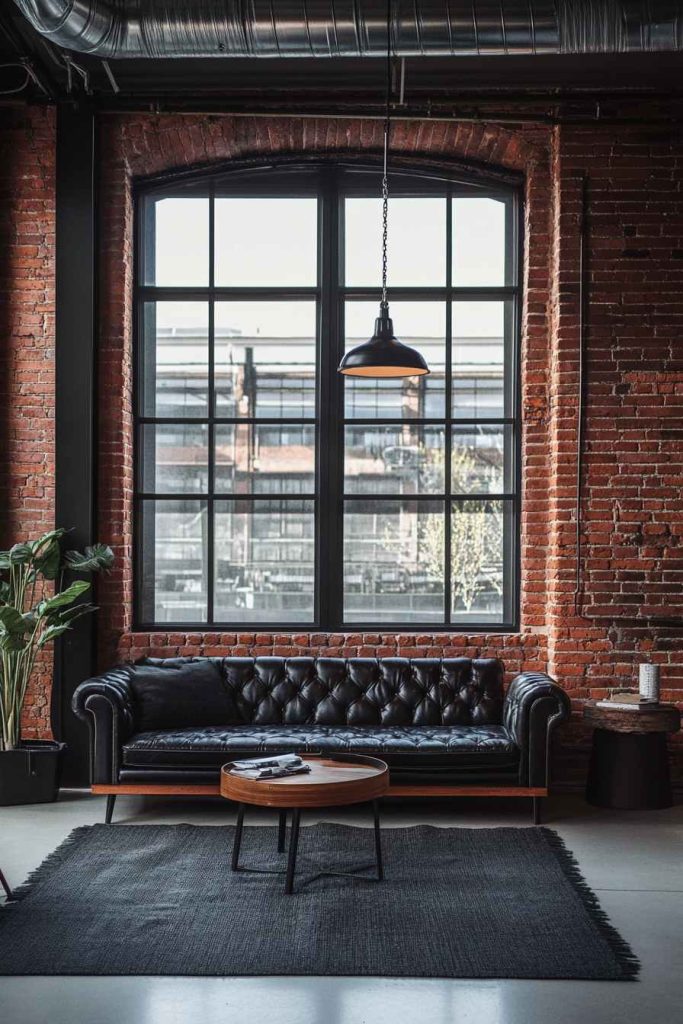
- Celebrate unrefined materials.
- Exposed mechanical elements (pipes, ductwork) act as complementary design features.
- Accent walls are rugged yet deliberate, enhancing the gritty elegance.
Scandinavian: Light Wood, Soft Gray Concrete
- Focuses on light, airiness, and natural warmth.
- Accent walls often use pale timber slats, soft-textured concrete, or subtle geometric ceramic tiles.
- Always layered with soft textiles and cozy lighting.
Mid-Century Modern: Walnut Panels, Stone Walls

- Rich, organic materials like walnut wood, travertine stone, and brick.
- Accent walls often frame built-in furniture, fireplaces, or art.
Japandi: Simple Wood, Muted Stone
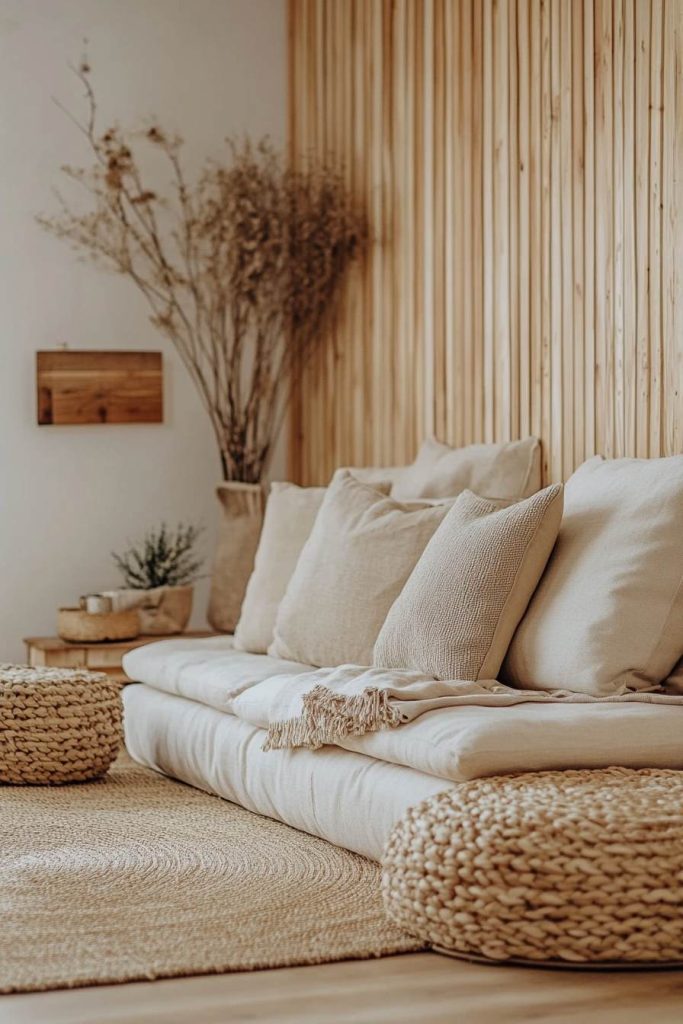
- A blend of Japanese minimalism and Scandinavian functionality.
- Emphasizes natural materials like light cedar wood, linen-textured concrete, and earth-toned ceramics.
- Clean lines, no ornamentation, and deep serenity.
Conclusion
Modern accent walls have transcended their decorative origins to become architectural centerpieces. Whether you’re drawn to the organic warmth of wood, the raw power of concrete, or the refined elegance of marble and glass, a well-chosen accent wall can transform a plain room into an extraordinary one. Thoughtful material choice, strategic placement, and expert lighting elevate an accent wall from a design choice to a design statement.
FAQ Section: Modern Accent Walls
Can I combine multiple materials on one accent wall?
Yes! Combining materials like wood and glass can add incredible depth and sophistication when done thoughtfully.
Are concrete walls cold or harsh for homes?
Not necessarily—paired with warm lighting and soft furnishings, concrete can feel cozy and stylish.
How durable are ceramic tiles on an accent wall?
Very durable, especially glazed varieties. They resist stains, moisture, and physical impact.
What’s the best accent wall material for small spaces?
Mirrors and glass panels are excellent for visually expanding small rooms.
Do I need special maintenance for marble walls?
Yes, marble is porous and needs sealing every year to maintain its luster and prevent staining.

